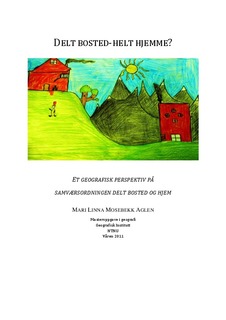| dc.description.abstract | We live in a fluid and mobile world, where rapid changes in our lives may suddenly occur. This is the case also for many people living in families. Family breakups are rather commonplace these days, being events usually representing major implications for all the family members affected by the changed living conditions, most often also meaning a change of residence, homestead and place. Such implications are particularly visible with the children affected by the breakups, whose lives now either have to be shared with only one parent, or to be shared between the two parents. In Norway the most common childcare arrangement after a divorce is that one of the parents gets the primary care responsibility, most commonly the mother. In a survey from 2004 about responsibility and care after the child support reform (Bidragsreformen) of 2003, Kitterød found that mothers got custody in 82 percent of all cases, fathers 8 percent, and 10 percent share custody for their children. This assignment is concerned about the last group; those who share custody for their children, also known as joint custody, (delt bosted).
This arrangement is a relatively new and not a very widespread one, but we can see a growing tendency towards following this new trend. Joint custody is, however, a controversial arrangement, having led to many debates around its implications for the children and whether or not this arrangement is to their best interests. The arrangement implies that children spend an equal amount of time with both their parents, even though those no longer live together. Joint custody may be arranged in different ways, but most frequently the child live part time in each of his/hers parents` homes, normally one week at each place (Skjørten, 2007) Thus these children have two places to call their home, and their parents live every other week without their children in their separate homes. Is this a bad way for children to grow up, a restless and unsecure form of dwelling, critics might ask? Or is it a right step towards making children useful adults fit for an increasingly mobile and changing world?
In my study I draw on my own experience, having a son living in joint custody for about seven years. Thus the background for my thesis is a curiosity about what this might mean for him and for his conception and personal relation to the notion of home. It is also based on how I myself experience my home, and my relation to home changing according to his presence or absence. What exactly is home, why do some places become homes, and can we relate home to several places?
Accordingly, the aim of this thesis is to study the particular family arrangement called joint custody, trying to get an understanding of how this is organized, and its impacts on both the parents` and the children’s experience of the place called home. Using geographical knowledge and theory about the concepts of place and home, I seek to illuminate questions related to these concepts. This is being done through the experiences of eight informants, two fathers and six mothers of children living in joint custody. The research was conducted by the author in the autumn 2008 in Trondheim, Norway, and applied through qualitative depth interviews.
Home certainly is a complex term which has been used in many different ways throughout time. Home is here understood as a place, which on its own is an important and a rather complex concept in geography. Both these concepts are outlined and discussed in chapter 3. I especially draw on Doreen Massey (1994, 2005) and her understanding of places as meeting places. This relational approach is also a key element in the critical geography of home formulated by Blunt and Dowling in their book Home (2006). | nb_NO |
